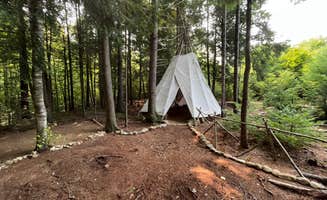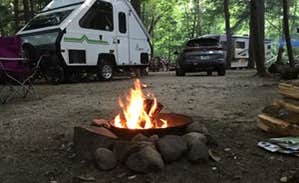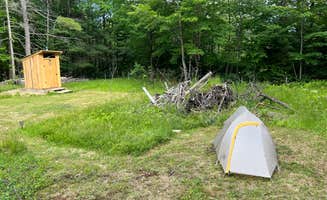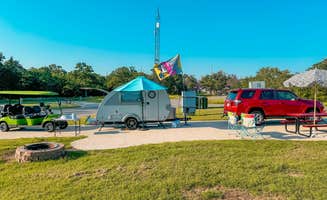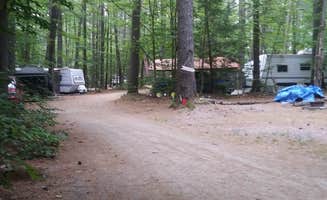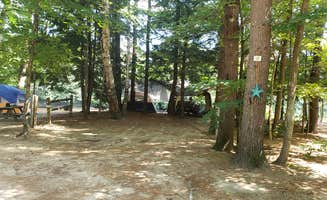Camping opportunities near Center Sandwich, New Hampshire range from rustic forest service sites to more developed campgrounds. The region sits at elevations between 550-1,000 feet with significant temperature swings from day to night, often dropping 20-30 degrees after sunset even in summer. Winter camping remains available at select locations like Hancock Campground, which stays open year-round despite heavy snowfall that can exceed 70 inches annually.
What to Do
Hiking accessible trails: Multiple campgrounds offer direct trail access without driving. At Campton Campground, one camper notes, "It's in a great location if you want to enjoy some popular hikes such as Welch-Dickey, with great open ledges, and the Osceolas." Trails vary in difficulty from family-friendly paths to challenging mountain climbs.
River activities: The Swift River provides excellent tubing and swimming opportunities near Jigger Johnson Campground, where "Different trailheads located on grounds that are a short walk down to the River that's great to take a tube on and float down then walk back up." Water levels are typically best between late May and early August.
Winter exploration: Unlike many seasonal campgrounds, year-round options exist. One winter camper at Hancock Campground reported, "Stayed here for two nights in late December. Site #40 along the river was close to the bathroom yet had plenty of privacy from other sites." Winter camping requires additional preparation but provides solitude rarely found in summer.
What Campers Like
Privacy between sites: Many campers appreciate spacing at Waterville Campground where "Sites are large with some privacy. The pine needle floor was soft and clean." Sites furthest from access roads typically offer the most seclusion.
Natural swimming spots: The region offers numerous natural water features beyond developed beach areas. At White Lake State Park, a visitor mentioned, "The lake itself is unreal, with the mountains in the background it just feels incredibly peaceful and serene, keeping in mind I mostly visited around dawn and dusk."
Fall foliage viewing: Autumn camping provides spectacular color displays. One camper at Branch Brook Campground shared, "Fall camping at branch brook is nothing short of magical. We just happened to book a trip right at peak season for fall foliage.... the colors were absolutely unreal." Peak foliage typically occurs between late September and mid-October.
What You Should Know
Bear activity: Multiple campgrounds report active bear populations. At Waterville Campground, a camper warned, "The first day I got there at around 5:30 I was sitting in my hammock reading when a black bear cub strolled through my campsite. We scared the poop out of each other. Local police came and said they have been having problems with the bears."
Bathroom facilities vary widely: Campground bathrooms range from rustic to modern. At Harbor Hill Camping Area, "The bathrooms are super clean (although somewhat small). Large single stall shower that was also very clean, operates on quarters." Many forest service campgrounds only offer vault toilets.
Road noise concerns: Some otherwise beautiful campgrounds struggle with highway proximity. One camper at Campton Campground reported, "The only sites that were available were the ones right next to the all hours busy road." Selecting sites furthest from main roads can significantly improve the camping experience.
Seasonal reservation patterns: Peak season (July-August) typically requires advance booking, while shoulder seasons offer more flexibility. Columbus Day weekend marks the end of season for many campgrounds, though some remain open later.
Tips for Camping with Families
Look for campgrounds with organized activities: Danforth Bay Camping & RV Resort offers numerous family programs. "We love the golf carts and sandy beaches as well as the proximity to North Conway and Lake Ossipee. Staff are nice, quiet time is a bit over enforced." Many family-oriented campgrounds offer weekend activity schedules.
Consider noise sensitivity: Families with young children should research quiet hours enforcement. At White Lake State Park, a camper noted, "Quiet hours are supposed to start at 10:00pm, but our rowdy male neighbors were up, playing music, talking loudly, and singing, until midnight." Sites near bathroom facilities often experience more foot traffic.
Pack for temperature fluctuations: Evening temperatures can drop significantly, even in summer. Bring layers for children, especially at higher elevation campgrounds where temperature swings can exceed 30 degrees between day and night.
Tips from RVers
Limited hookup options: Full-service sites are concentrated at private campgrounds. At Lost River Valley Campground, campers appreciate that "Wooded sites but close to your neighbors. We had site 41 & unfortunately we were unable to use the fire pit due to being so close to our 19 foot camper." Position is important when selecting sites.
Winter access considerations: For cold weather camping, road conditions become critical. One winter camper warned, "They do a bad job plowing (my rig bottomed out twice on snow banks) and I fishtailed on the access road." Call ahead to confirm winter maintenance practices if planning off-season visits.
Size restrictions on forest service campgrounds: Many White Mountain National Forest campgrounds cannot accommodate larger rigs. Most forest service sites work best for RVs under 30 feet, with private campgrounds offering more options for larger vehicles.


